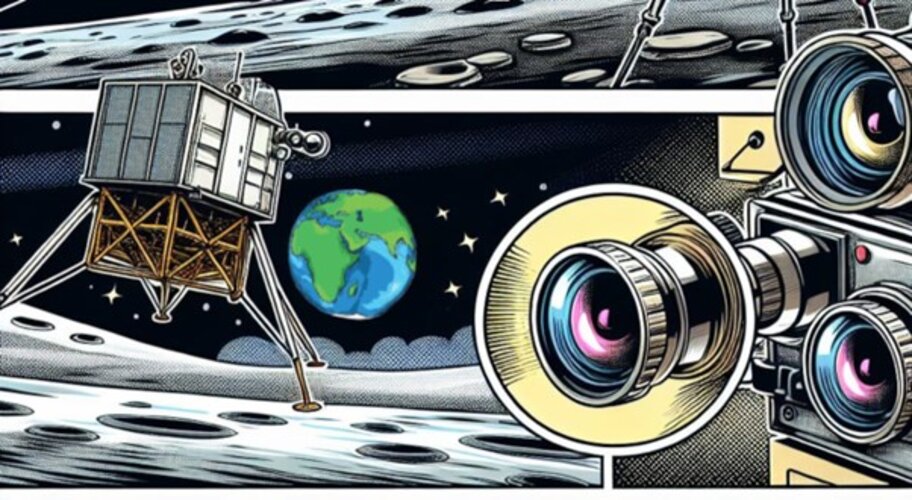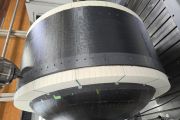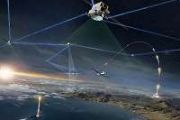
Copernical Team
ESA unveils longest-ever dataset on forest biomass

As the new Biomass satellite settles into life in orbit following its launch on 29 April, ESA has released its most extensive satellite-based maps of above-ground forest carbon to date. Spanning nearly two decades, the dataset offers the clearest global picture yet of how forest carbon stocks have changed over time.
Developed through ESA’s Climate Change Initiative, this new long-term record integrates data from multiple satellite missions – and will soon be further enhanced by data from the Biomass mission itself.
‘ELOPE’ with ESA’s moon landing guidance competition

Mapping the descent of a lunar lander, using nothing but data from an ‘event camera’ – this is the next challenge presented to the space community by the European Space Agency’s Advanced Concepts Team (ACT).
Space is a place to found a community not a colony
 China's Shenzhou XIX crew has officially handed over control of the Tiangong space station to the incoming Shenzhou XX crew, marking another milestone in the nation's growing space ambitions. Following the successful completion of their mission objectives, the Shenzhou XIX astronauts are now preparing to return to Earth.
The Tiangong space station, which has seen multiple crewed missions o
China's Shenzhou XIX crew has officially handed over control of the Tiangong space station to the incoming Shenzhou XX crew, marking another milestone in the nation's growing space ambitions. Following the successful completion of their mission objectives, the Shenzhou XIX astronauts are now preparing to return to Earth.
The Tiangong space station, which has seen multiple crewed missions o SFL Missions launches new era of small satellite innovation with expanded services
 SFL Missions Inc. is charting a new path in small satellite development by building on the legacy of the Space Flight Laboratory (SFL), with an emphasis on affordability, innovation, and global service delivery.
Founded by Dr. Robert E. Zee, SFL Missions inherits over two decades of success from SFL, including 86 operational missions and more than 370 cumulative years of spacecraft perform
SFL Missions Inc. is charting a new path in small satellite development by building on the legacy of the Space Flight Laboratory (SFL), with an emphasis on affordability, innovation, and global service delivery.
Founded by Dr. Robert E. Zee, SFL Missions inherits over two decades of success from SFL, including 86 operational missions and more than 370 cumulative years of spacecraft perform Carbice thermal tech to enhance heat control on SWISSto12 HummingSat satellites
 Carbice, known for its advanced thermal management solutions, has announced a new partnership with Swiss satellite manufacturer SWISSto12 to supply its Carbice Space Pad to the innovative HummingSat platform. This collaboration aims to address the escalating thermal challenges of compact, high-performance geostationary satellites.
As satellite systems grow increasingly powerful while shrin
Carbice, known for its advanced thermal management solutions, has announced a new partnership with Swiss satellite manufacturer SWISSto12 to supply its Carbice Space Pad to the innovative HummingSat platform. This collaboration aims to address the escalating thermal challenges of compact, high-performance geostationary satellites.
As satellite systems grow increasingly powerful while shrin Apex secures 200 million to ramp up satellite bus production
 Apex Space has closed a $200 million Series C funding round to expand its production of standardized, high-volume satellite buses. The funding, led by Point72 Ventures and co-led by 8VC, includes participation from Andreessen Horowitz, Washington Harbour Partners, StepStone Group, and other investors.
The investment will accelerate Apex's ability to meet growing demand from both government
Apex Space has closed a $200 million Series C funding round to expand its production of standardized, high-volume satellite buses. The funding, led by Point72 Ventures and co-led by 8VC, includes participation from Andreessen Horowitz, Washington Harbour Partners, StepStone Group, and other investors.
The investment will accelerate Apex's ability to meet growing demand from both government Nearby molecular hydrogen cloud discovered using far ultraviolet light
 An international team led by Rutgers University has uncovered one of the closest known molecular hydrogen clouds to our solar system, using far-ultraviolet light to detect what had long been hidden. Named "Eos," this massive crescent-shaped structure lies just 300 light years from Earth and spans an area roughly 40 times the size of the full moon in the night sky.
Eos is among the largest
An international team led by Rutgers University has uncovered one of the closest known molecular hydrogen clouds to our solar system, using far-ultraviolet light to detect what had long been hidden. Named "Eos," this massive crescent-shaped structure lies just 300 light years from Earth and spans an area roughly 40 times the size of the full moon in the night sky.
Eos is among the largest Magnetar flares emerge as possible source of early cosmic gold
 as gold, get created and distributed throughout the universe?
"It's a pretty fundamental question in terms of the origin of complex matter in the universe," said Anirudh Patel, a doctoral student at Columbia University in New York. "It's a fun puzzle that hasn't actually been solved."
Patel led a study using 20-year-old archival data from NASA and ESA telescopes that finds evidence f
as gold, get created and distributed throughout the universe?
"It's a pretty fundamental question in terms of the origin of complex matter in the universe," said Anirudh Patel, a doctoral student at Columbia University in New York. "It's a fun puzzle that hasn't actually been solved."
Patel led a study using 20-year-old archival data from NASA and ESA telescopes that finds evidence f Inouye Solar Telescope activates powerful new spectro polarimeter for detailed Sun studies
 The Inouye Solar Telescope, the world's largest solar observatory, has reached a critical milestone with the activation of its most advanced instrument to date: the Visible Tunable Filter (VTF), a massive spectro-polarimeter now operational atop Hawaii's Haleakala volcano. With a four-meter primary mirror, the telescope has delivered remarkable solar images since 2022, and the VTF dramatically e
The Inouye Solar Telescope, the world's largest solar observatory, has reached a critical milestone with the activation of its most advanced instrument to date: the Visible Tunable Filter (VTF), a massive spectro-polarimeter now operational atop Hawaii's Haleakala volcano. With a four-meter primary mirror, the telescope has delivered remarkable solar images since 2022, and the VTF dramatically e Juno reveals subsurface secrets of Jupiter and Io
 NASA's Juno mission has delivered unprecedented insights into the subsurface dynamics of both Jupiter and its volcanic moon, Io. The spacecraft's latest observations have unveiled the temperature structure beneath Jupiter's cloud cover and mapped residual volcanic heat beneath Io's surface.
Using its Microwave Radiometer (MWR) and Jovian Infrared Auroral Mapper (JIRAM), Juno captured data
NASA's Juno mission has delivered unprecedented insights into the subsurface dynamics of both Jupiter and its volcanic moon, Io. The spacecraft's latest observations have unveiled the temperature structure beneath Jupiter's cloud cover and mapped residual volcanic heat beneath Io's surface.
Using its Microwave Radiometer (MWR) and Jovian Infrared Auroral Mapper (JIRAM), Juno captured data 






























